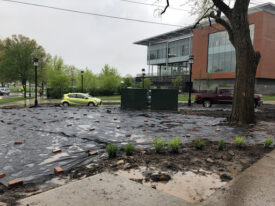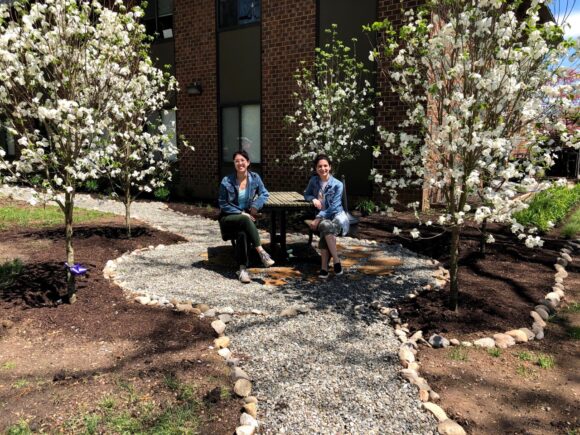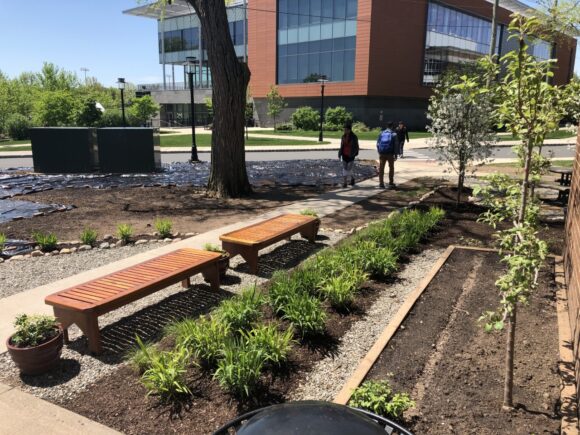By Darrian Beam (SEBS ’21), Green Team Steward, Rutgers School of Environmental and Biological Sciences (SEBS)
One of my favorite past-times at school is taking a walk around Rutgers Cook campus. When I’m stressed about exams and assignments, it’s a real treat to stroll through the greenery here and let my thoughts wander. Although we do not have access to campus now, we can still learn about what projects are going on. While class was still in-person, you may have noticed some abnormalities in the gardens on Cook—sky high piles of leaves and spray painted tarps on the ground. Although they may look a little odd, these “sore thumbs” are actually puzzle pieces to the SEBS Living Labs initiative. Through Living Labs, the campus grounds, buildings and operations become portals to engaged learning.
Living Labs projects exist on all Rutgers campuses, but are especially lively and visible on Cook. Here, students and professors have been able to experiment with material inputs and methods for growing and maintaining a collection of sustainable gardens. Here we’ll explore some of our unconventional approaches to landscaping as well as the lessons learned from our experiences.

Solarization using black plastic, in front of Cook Office Building, facing IFNH. Photo courtesy of Darrian Beam.
Garden Installation at the Cook Office Building
One of the most empowering things we can do for students is provide real-world experience. SEBS Department of Landscape Architecture professors Holly Nelson and Christina Kaunzinger did just this with their Planting Design class last Spring. Students were split into groups and asked to devise a Provisioning Garden for the space outside of the Cook Office Building. Building residents from the Departments of Human Ecology and Agricultural, Food, and Resource Economics voted on their favorite designs: Jessica MacPhee (SEBS ’20) and Nina Petracca’s (SEBS ’20, SGS ’21) design was selected for installation. The design beautifully intertwines the aspects of environmentalism, creativity and deep thinking which underlay the SEBS community (see Provisioning Garden is the Newest Living Laboratory on the Cook Campus).
Like all good projects, this one faced challenges. A big question for the class was how to handle the spread of weeds. The answer lay in the black and technicolor spray painted tarp which was placed over the site for a full growing season. What some may have guessed was prep for a construction site, was actually a mechanism for weed control. The tarp kills weeds and their seed bank via solarization. The conventional approach to weed control is to apply an herbicide, but runoff from the chemical input can harm the surrounding ecosystems. The tarp on the other hand, isolates the damage to its target.

Jess MacPhee (l) and Nina Petracca in the Cook Office Building garden, dedicated to retired Human Ecology professor George F. Clark. Photo courtesy of Jess MacPhee.
Using Leaves as Mulch
Another experiment involves using fallen leaves as mulch. You may have seen large piles of leaves in the IFNH meadow or border gardens. The allocation and implementation of the leaves for mulching is the result of a collaboration between campus Facilities and the student Green Team.
This tactic has multiple benefits. This approach requires no chemical input. We are using nature to nurture itself. The leaves break down and contribute to nutrient cycling among the native plants on campus. Additionally, the organic material in the leaves holds onto moisture—in drier weather this can be helpful in preventing dry soil and potential loss of plants. From an economic standpoint, using naturally occurring materials eliminates the need to purchase mulch from outside sources as well as the need to pay a company to remove the leaves from campus (while also reducing the carbon costs associated with travel). This saves Facilities money, which ultimately saves New Jersey taxpayers and Rutgers students money.
Student Input
The practice of sustainable landscaping on campus allows our community to realize new potential in the ways we interact with the natural world. A lot of these efforts are to show our community that living in harmony with our environment is doable! A highlight of the Living Labs and Green Team efforts is the ability to share what we discover. That being said, formerly mentioned student, Jess MacPhee, expressed that she would like to see more participation from the student body as a whole, stating, “this is something we need to tackle, green team/gardening offers a socially diverse opportunity. We should be collaborating with other clubs to address issues like food insecurity/soil preservation.”
As the Living Labs evolve, this should spark conversation and involvement from students on all campuses. We should be thinking about how culture, perspective and diversity play into our relationships with each other and the land we share.
Editor’s note: Green Team members are stewards of the “Living Labs,” the teaching landscapes of the Cook/Douglass campuses. In collaboration with classes, volunteers and the Rutgers Grounds crew, the Green Team designs, installs, maintains, monitors and champions sustainable landscapes.


